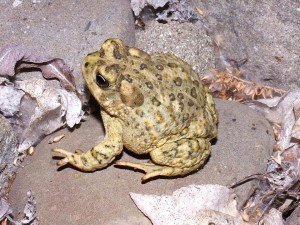Ventura, Calif. – Today, the U.S. Fish & Wildlife Service formally withdrew its proposal to downgrade the status of the arroyo toad from “endangered” to “threatened” under the Endangered Species Act. The controversial plan – first proposed in 2012 – was not supported by current scientific data, and would have reduced the level of protection for arroyo toads in the Los Padres National Forest and elsewhere throughout its range.
The arroyo toad is a small, 2-3 inch toad with very specific habitat requirements. It is only found in rivers with shallow, gravelly pools adjacent to sandy terraces. The majority of the remaining populations in Santa Barbara and Ventura Counties are located in the Los Padres National Forest in the Sespe, Sisquoc, Santa Ynez, and Piru watersheds.

Photo courtesy Dr. Sam Sweet
Arroyo toads were historically found throughout streams and rivers in southern California, from San Luis Obispo County to San Diego County, but now they survive in small isolated populations in the headwaters of these watersheds. Urbanization and dam construction beginning in the early 1900s caused most of the extensive habitat degradation. Other factors contributing to the toad’s decline include stream diversions, recreational trampling, road maintenance through streams, in-stream mining and dredging, livestock grazing, off-highway vehicles, and invasive predatory species like bullfrogs.
These threats prompted the U.S. Fish & Wildlife Service (“Service”) to add the arroyo toad to its formal list of endangered species in 1994. The toad’s “endangered” status provided the highest level of protections under the federal Endangered Species Act. Biologists prepared a Recovery Plan in 1999 to outline several steps needed to bring the toad back from the brink of extinction, including establishing twenty “self-sustaining” populations throughout its range.
As arroyo toad populations continued to decline, extractive industries sued the Service to remove these much-needed protections, and in response the FWS formally proposed to change the toad’s status to “threatened” in 2012. Many experts believed that this was a political move designed to show that success was being made towards recovering the arroyo toad, even though the best scientific data seemed to show that the toads were still teetering on the brink of extinction.
ForestWatch teamed up with our partners at the Center for Biological Diversity to submit a detailed critique of the Service’s proposal, pointing out that it was only based on population surveys at four locations with the healthiest populations, and that no surveys had been conducted across the toad’s entire range to provide a bigger picture of the overall health of the species. We also noted that the criteria outlined in the toad’s Recovery Plan – twenty self-sustaining populations – have not been met.
Today’s decision to retain “endangered” listing was based primarily on these concerns. The Service now agrees that the arroyo toad continues to face the same threats that prompted its “endangered” listing in the first place, and that new threats like invasive nonnative tamarisk plants and the effects of climate change are only making matters worse. The Service now admits that its own Recovery Plan goals have not been met, and that no long-term population trend data is available to demonstrate that arroyo toad populations are stable. In fact, experts are now concerned that all of the surveyed populations in the Los Padres National Forest are experiencing recent declines, likely due to the ongoing drought and other factors.
Because of our collective efforts, arroyo toads will continue to receive the highest level of protection under federal wildlife laws. Losing their “endangered” status would have been devastating to ongoing efforts to bring arroyo toads back from the brink of extinction.
We hope that one day, we can celebrate the recovery of arroyo toads as they reach sustainable population numbers throughout their historic range. But until then, any proposals to strip “endangered” protections from this species – like this one – are clearly politically motivated and premature. ForestWatch will continue to demand the strongest protections possible for the arroyo toad and the streams it inhabits throughout the Los Padres National Forest.







Comments are closed.